The majority of Elow’s nonprofessionals were cajoled into believing that their appearance would hurl them into cabaret stardom. Generally, they were Berlin’s losers: Gogol-like office clerks who believed that their true calling was comic recitation or juggling; frustrated housewives who once trained in Bayreuth; incompetent teenage magicians; tin-eared composer-and-lyricist teams; hypnotists who were banned from the variety circuit because of their chronic inability to bring their volunteer subjects out of deep trance; mad Napoleonic-posturing poets; and psychologically impaired dilettantes who assumed their renditions and imitations of Wintergarten headliners were superior to the originals.
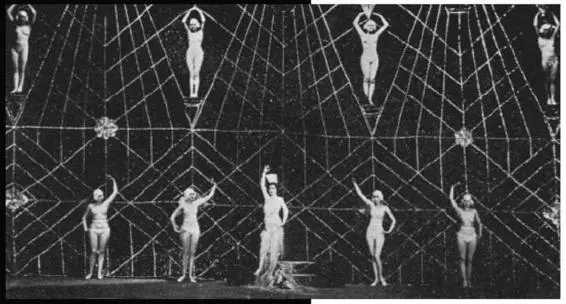
James-Klein Revue, The World Unveiled , 1924
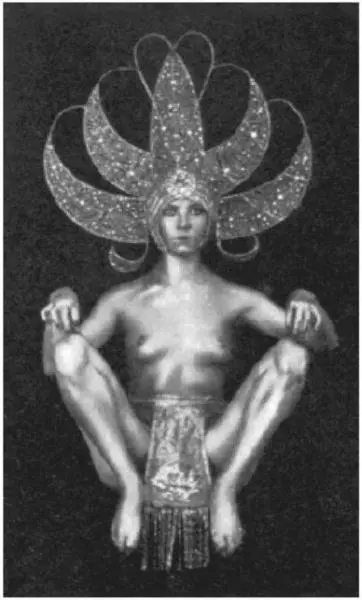
“Indian Goddess” in revue sketch
At the low point in each act—and Berlin’s journalists reported many such moments—Elow jumped on the stage and mockingly polled the audience whether or not to allow the “artiste” to continue. Only the most pathetic and hopeless creatures were encouraged to complete their number. (A few really schizophrenic or severely incapacitated performers were told by an effusive Elow that their painfully conceived routine was so absolutely smashing that they should restart the whole thing.)
The toxic Stimmung at the Nameless was further enhanced by Elow’s abusive taunts directed at the hard-drinking spectators, who often responded with hearty anti-Semitic invective. The Cabaret of the Nameless played to full houses almost into the Nazi period. Elow, the peripatetic imp, ended up in Hollywood, where he vanished into American show-biz obscurity, leaving behind just an archive of his Berlin press clippings.
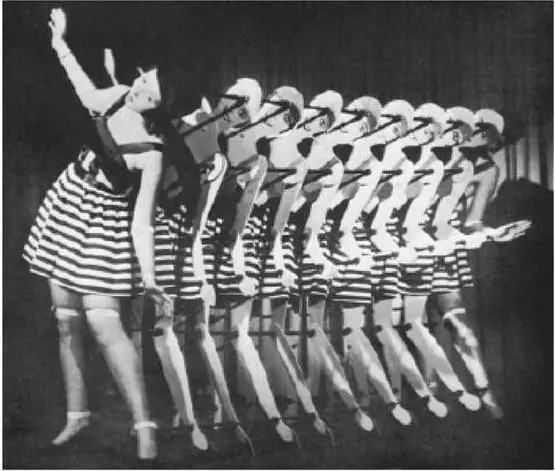
Grit and Ina van Elben’s dancing-machine at the Tingel-Tangel, 1931
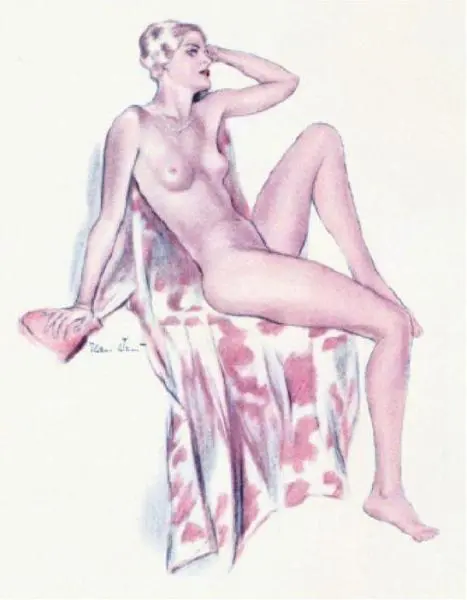
In the mid-Twenties, erotic revue, another Ziegfeld invention, supplanted cabaret as Berlin’s stylish Jazz Age destination. It combined the lavish features of operetta and Music Hall in the old cabaret format. Like the variety show, its principal competitor, the program of the revue unfolded in episodic set pieces. Olio acts followed spectacle numbers; comic interludes punctuated the space between extravagant choreographic and musical displays. In the revue, however, an underlying aesthetic and dramatic thesis held the evening together. A single team of creators assembled and molded the production. Foreign dance troupes or renowned starlets could be dropped into the show at any time, but their independent routines had to further the revue’s “plot.”
Although conceived in Paris and New York, the erotic revue blossomed in sensation-hungry Berlin. It was mammoth, hectically paced, thoroughly cosmopolitan, and oozed Girl-Culture sex. Berliners flocked to the revue-palaces, bought the Tin Pan Alleyish recordings, marveled at the chorus girls’ legs (which became iconic images in the pictorial monthlies). Revues were a testament to Berlin sophistication—what other city had its own Gesamtkunstwerk erotica? But the revue structure also spoke, in a subterranean way, to the Germanic need to control desire through objectification and derision.
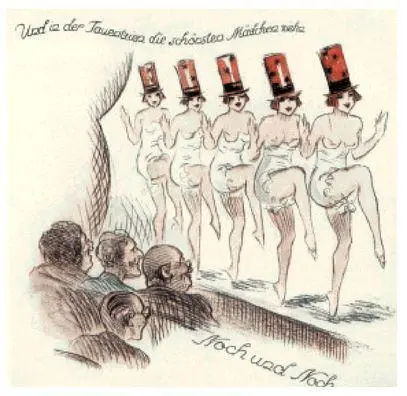
The Tiller Girls
Each of the eight major revue-theatres had its own distinct appeal and style of presentation. One was noted for its exquisite dance numbers and kaleidoscopic scenery; one hired better composers and Schnauzer lyricists; another veered to the experimental or hot topical issues; still another was famed for using only glamorous Girl-Groups from aboard. But no revue-producer was more detested by his colleagues or more beloved by the voyeuristic public than James Klein, who excelled in mounting season after season of hit shows blanketed with excessive amounts of gratuitous female nudity.
A typical James Klein Revue began with a simple dramatic premise: an obese Oriental prince learns that he will be disinherited in five years if he does not marry and produce male heirs. (Big naked harem number.) The chubby, disgruntled simp immediately enlists his lackey Cohen (incidentally all the revue directors were Jewish) to find the finest specimen of raw feminine beauty on the entire planet. Cohen then subcontracts the onerous task to two Berlin playboys, who obediently traverse the world’s fleshpots in order to win the million (post-inflationary) mark reward. Their journey takes them to every continent, although the nude aboriginals are always milky-white and look suspiciously French, with stopovers in Berlin’s Kietz and a heavenly apparition of 74 perky, rouged breasts. (Count ’em!)
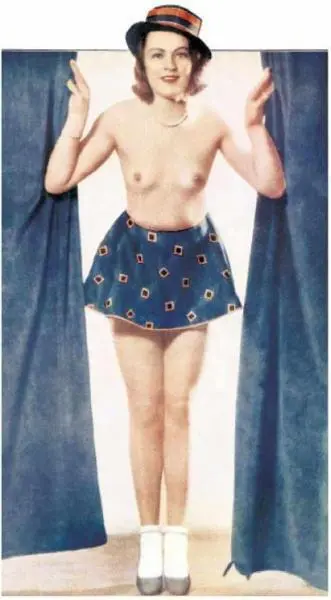
Scala Revue Girl
The 1929 depression brought down the curtains on Klein’s erotic dreamscapes. His last show was titled Goddamnit! 1,000 Naked Women! , which might have been a tad ambitious. Klein remained in Berlin in the Thirties, contented that he avoided his creditors and bankruptcy proceedings. Nothing is known about his fate afterwards. It was assumed that he fell victim to the Nazi genocide.
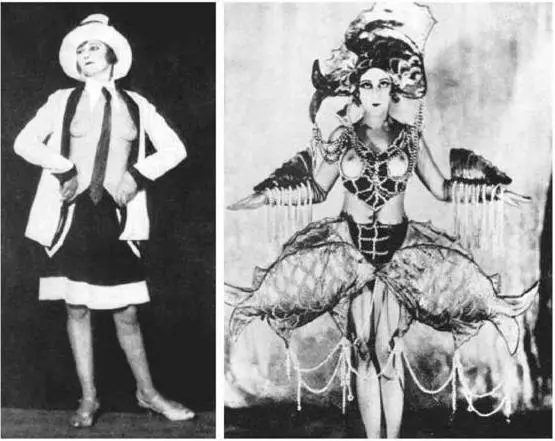
Futuristic fashions from Klein’s Everyone Naked , 1927
Klein’s fellow revue-directors lost their theatres as well during the economic tailspin. Yet the hard-partying denizens of Berlin were unfazed. They discovered a new venue for their pursuit of the extraordinary: environmental restaurants and Gargantuan nightclub retreats.
Theme Restaurants and Pleasure Palaces
In 1932, the city of Berlin approved licenses for 119 “luxury-class” nightclubs, 400 bars or Dielen , and 20,000 restaurants. This meant Weimar Berlin had one dining establishment for every 280 residents (the ratio in New York City in that year was 1 to 433). For the most part, the food in Berlin was not of great interest to the non-German tourists; Paris, Vienna, and Rome satisfied that craving in spades. Instead, Berlin had dozens of “theme” and “event” restaurants. They rivaled the cabarets and revue-houses in popularity.
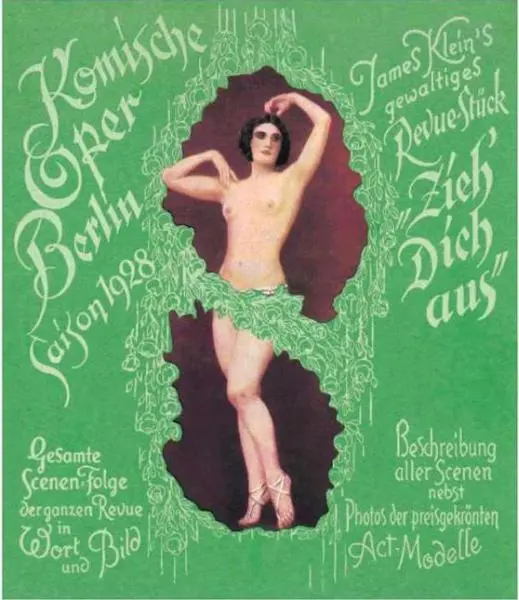
James-Klein Revue program cover, Take It Off! , 1928
One unusual joint was the “Hackepeter,” north of the Alex. Named after the Rheinish specialty (chopped raw pork and minced onion drizzled in hot, bubbling lard), the restaurant featured a “Hunger Artist.” Encased in a sealed glass booth, Jolly sat in his underwear and chain-smoked cigarettes. Two funeral-attired “observers” alternated during the 24-hour proceedings, ensuring no food ever graced the hunger artist’s lips. During dining hours, a midget announced the number of days and hours that Jolly fasted in his binge of voluntary starvation. Usually the Hackepeter regulars showed their appreciation by tapping against beer steins with their greasy utensils.
Читать дальше




















